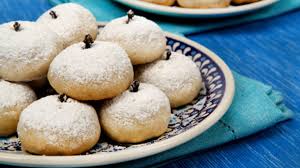
Kourambiedes are traditional Greek sweets that are made at Christmas. They are a shortbread biscuit that is covered with icing sugar. The icing sugar that covers them reminds you of the snow that falls during winter when Christmas and New Year are celebrated.
It is said that this shortbread sweet originated in Persia. During the Ottoman Empire it was introduced to Greece. Kourambie (Greek: κουραμπιέ) comes from the Turkish ‘Kurabiye’. At Christmas, a single dark clove is often put on top to represent the spices of frankincense and myrrh that the Magi brought to baby Jesus on his birth. Kourambiedes can be round in shape, crescent shaped or even star shaped. The secret behind a good kourambie is the butter that is used. Kavala, in northern Greece, is famous for making the best kourambiedes.
In the Balkan Wars of 1912-13, the term ‘kourambies’ was used as a form of slang for soldiers that looked strong and promising, but crumbled the minute they were in battle just like the sweet crumbles as soon as you bite it. This term was also used in World War II by the Greek soldiers to describe Mussolini’s Italian soldiers because they showed a weak will and easily crumbled in battle.
Below is a traditional recipe for kourambiedes.
Ingredients
500 gr unsalted butter at room temperature
2 cups of toasted blanched almonds
2 egg yolks
2 tablespoons Cognac/Brandy
3/4 cup of castor sugar
250 gr (approximately) of s.r. flour
Instructions
- Lightly toast almonds then grind to large coarse pieces.
- Beat the butter with the sugar until creamy. Add the egg yolks. Beat well.
- Add the brandy.
- Remove from beater and fold in the almonds.
- Add the sifted flour a little at a time until the dough is soft and smooth and no longer sticks to your hand.
- Shape into traditional kourambie shapes. Bake on ungreased sheets for 10-12 minutes at 340F / 170 C. The kourambiedes should not brown. They should bake to a pale beige-golden color. Remove and cool slightly.
- Sift confectioner’s sugar over the cookies.
- Place on platter that has a layer of confection sugar on it.